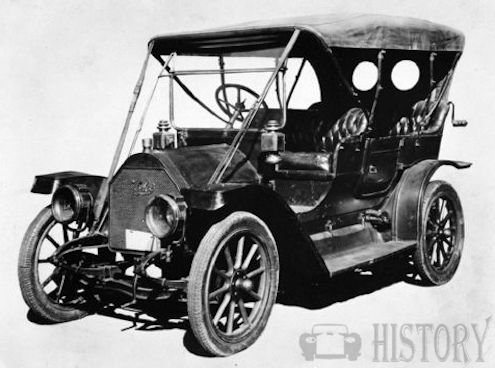Velie (Velie Motors Corporation)
The Velie was an American car, which by the Velie Motors Corporation in Moline (Illinois) was produced from 1908 to 1929. The company was founded by Willard Velie , a grandson of John Deere .
Velie advertising pamphlets emphasized that the company made every important part of its own and not just purchased parts, a lesson they learned from Ford .
The Veli 40 of 1911 had a side-drive four-cylinder in-line engine with 5473 cc, Splitdorf -Magnetzünder and a power of 40 bhp (29 kW) and a Brown-Lipe spur-three-speed transmission. It was a four-seater with 2921 mm wheelbase, 34 "wood spoke wheels and tires - depending on customer requirements of Hartford or Firestone . The car cost US $1800
Velie produced 9000 cars in 1920. During the 1920s, the Velie automobiles were powered by six-cylinder Continental engines, but there was also an inline eight-cylinder with a Lycoming engine. From 1924 Velie used battery ignitions from Westinghouse Electric instead of the magneto ignition . The Velie Royal Sedan was the first car whose A-pillars were tilted backwards, which also gave the windshield a significant tilt (shown below).
The company also manufactured airplanes for several years. The Velie Monocoupe was one of the first aircraft for private pilots. In addition, they also produced aircraft engines, such as the Monocoupe 70 .
Willard Velie died in 1928 and his family stopped producing the Velie automobiles in January 1929. Monocoupe was sold to Phil Ball , a businessman from St. Louis, Missouri, and supporter of Charles Lindbergh . Monocouple aircraft were then built in St. Louis for several years.
1927 Velie Model-60 Royal Sedan

Technical
-
Car Models
model Construction period cylinder power wheelbase A, B 1909 4 row 35 bhp (26 kW) 2794 mm D, E, F 1910 4 row 40 bhp (29 kW) 2921 mm G 1911 4 row 40 bhp (29 kW) 2921 mm H, O 1912 4 row 40 bhp (29 kW) 2921 mm M, N 1912 4 row 40 bhp (29 kW) 2997 mm L 1912 4 row 40 bhp (29 kW) 3073 mm 32, Dsipatch 1913 4 row 32 bhp (23.5 kW) 2870 mm 40 1913 4 row 40 bhp (29 kW) 2997 mm 5 1914 4 row 26 bhp (19 kW) 2870 mm 9 1914 4 row 34 bhp (25 kW) 3073 mm 10 1914 6 row 34 bhp (25 kW) 3200 mm Biltwel 1915 6 row 29 bhp (21 kW) 3150 mm Big Four 1915 4 row 34 bhp (25 kW) 3150 mm Big Six 1915 6 row 34 bhp (25 kW) 3251 mm Biltwel 22 1916 6 row 25 bhp (18.4 kW) 2921 mm Biltwel 15 1916 4 row 29 bhp (21 kW) 3150 mm Biltwel Six-28 1917 6 row 25 bhp (18.4 kW) 2921 mm Biltwel Six-27 1917 6 row 29 bhp (21 kW) 3150 mm 38 1918-1919 6 row 25 bhp (18.4 kW) 2921 mm 39 1918-1919 6 row 29 bhp (21 kW) 3150 mm 34 1920-1922 6 row 37 bhp (27 kW) 2845 mm 48 1920-1922 6 row 55 bhp (40 kW) 2921 mm 58 1922-1924 6 row 45-47 bhp (33-34.5 kW) 2921-2997 mm 60 1925-1927 6 row 48 bhp (35 kW) 2997 mm 66 1928-1929 6 row 50 bhp (37 kW) 2845 mm 77 1928-1929 6 row 60 bhp (44 kW) 2997 mm 88 1928-1929 6 row 90 bhp (66 kW) 3175 mm



